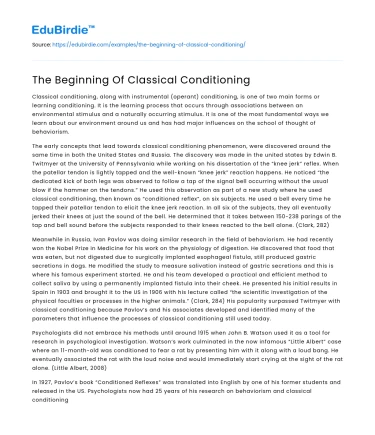Classical conditioning, along with instrumental (operant) conditioning, is one of two main forms or learning conditioning. It is the learning process that occurs through associations between an environmental stimulus and a naturally occurring stimulus. It is one of the most fundamental ways we learn about our environment around us and has had major influences on the school of thought of behaviorism.
The early concepts that lead towards classical conditioning phenomenon, were discovered around the same time in both the United States and Russia. The discovery was made in the united states by Edwin B. Twitmyer at the University of Pennsylvania while working on his dissertation of the “knee jerk” reflex. When the patellar tendon is lightly tapped and the well-known “knee jerk” reaction happens. He noticed “the dedicated kick of both legs was observed to follow a tap of the signal bell occurring without the usual blow if the hammer on the tendons.” He used this observation as part of a new study where he used classical conditioning, then known as “conditioned reflex”, on six subjects. He used a bell every time he tapped their patellar tendon to elicit the knee jerk reaction. In all six of the subjects, they all eventually jerked their knees at just the sound of the bell. He determined that it takes between 150-238 parings of the tap and bell sound before the subjects responded to their knees reacted to the bell alone. (Clark, 282)
Save your time!
We can take care of your essay
- Proper editing and formatting
- Free revision, title page, and bibliography
- Flexible prices and money-back guarantee
Meanwhile in Russia, Ivan Pavlov was doing similar research in the field of behaviorism. He had recently won the Nobel Prize in Medicine for his work on the physiology of digestion. He discovered that food that was eaten, but not digested due to surgically implanted esophageal fistula, still produced gastric secretions in dogs. He modified the study to measure salivation instead of gastric secretions and this is where his famous experiment started. He and his team developed a practical and efficient method to collect saliva by using a permanently implanted fistula into their cheek. He presented his initial results in Spain in 1903 and brought it to the US in 1906 with his lecture called “the scientific investigation of the physical faculties or processes in the higher animals.” (Clark, 284) His popularity surpassed Twitmyer with classical conditioning because Pavlov’s and his associates developed and identified many of the parameters that influence the processes of classical conditioning still used today.
Psychologists did not embrace his methods until around 1915 when John B. Watson used it as a tool for research in psychological investigation. Watson’s work culminated in the now infamous “Little Albert” case where an 11-month-old was conditioned to fear a rat by presenting him with it along with a loud bang. He eventually associated the rat with the loud noise and would immediately start crying at the sight of the rat alone. (Little Albert, 2008)
In 1927, Pavlov’s book “Conditioned Reflexes” was translated into English by one of his former students and released in the US. Psychologists now had 25 years of his research on behaviorism and classical conditioning that led to an increase in the interest in the experimental conditioning.
Today we can see influence of classical conditioning in responses such as phobias, disgust, nausea, anger and sexual arousal. For example, if someone eats a food that ends up making them sick, they are likely to have strong feelings of nausea the next time they encounter that food. Pavlov’s work also let to important behavioral therapy techniques such as flooding and desensitizing for individuals who suffer from fear and anxiety. (Boundless, 2019)
Classical condition is always happening around us and it effect the behavior in us every day of our lives. It has helped psychologists understand normal and disordered behavior in animals and humans. It is useful in training pets, helping those who suffer from anxiety disorders, and is also found use in the classroom by teachers creating and positive classroom environment for their students. (Cherry, 2019)
References
- Clark, R. E. (2004). The Classical Origins of Pavlov’s Conditioning.
- Integrative Physiological & Behavioral Science, 39(4), 279–294. https://proxy.nvc.alamo.edu:2855/10.1007/BF02734167
- Bouton, M. E. (2013). Conditioning and learning. In R. Biswas-Diener & E. Diener (Eds), Noba textbook series: Psychology. Champaign, IL: DEF publishers. DOI:nobaproject.com.
- Cherry, K. (2019, September 5). How Classical Conditioning Works: An Overview With Examples. Retrieved from https://www.verywellmind.com/classical-conditioning -2794859.
- Boundless. (n.d.). Boundless Psychology. Retrieved from https://courses.lumenlearning.com/boundless-psychology/chapter/classical-conditioning/.
- Little Albert. (2008). Psychologist, 21(9), 759. Retrieved from http://proxy.nvc.alamo.edu:2053/login.aspx?direct=true&db=pbh&AN=34288193&site= ehost-live






 Stuck on your essay?
Stuck on your essay?

